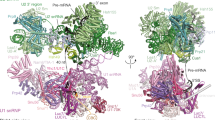Abstract
THE removal of introns from messenger RNA precursors requires five small nuclear RNAs (snRNAs), contained within ribonucleoprotein particles (snRNPs), which complex with the pre-mRNA and other associated factors to form the spliceosome (reviewed in refs 1–3). In both yeast and mammals, the U2 snRNA base pairs with sequences surrounding the site of lariat formation4–9. Binding of U2 snRNP to the highly degenerate branchpoint sequence in mammalian introns is absolutely dependent on an auxiliary protein, U2AF, which recognizes a polypyrimidine stretch adjacent to the 3′ splice site10. The absence of this sequence motif in yeast introns has strengthened arguments that the two systems are fundamentally different10,11. Deletion analyses of the yeast U2 gene have confirmed that the highly conserved 5′ domain is essential, although the adjacent ˜950 nucleotides can be deleted without any phenotypic consequence12,13. A 3′-terminal domain of ˜100 nucleotides is also required for wild-type growth rates; the highly conserved terminal loop within this domain (loop IV) may provide specific binding contacts for two U2-specific snRNP proteins13–15. We have replaced the single copy yeast U2(yU2) gene with human U2(hU2), expecting that weak or no complementation would provide an assay for cloning additional splicing factors, such as U2AF. We report here that hU2 can complement the yeast deletion with surprising efficiency. The interactions governing spliceosome assembly and intron recognition are thus more conserved than previously suspected. Paradoxically, the conserved loop IV sequence is dispensable in yeast.
Similar content being viewed by others
References
Padgett, R. A., Grabowski, P. J., Konarska, M. M., Seiler, S. & Sharp, P. A. A. Rev. Biochem. 55, 1119–1150 (1986).
Green, M. R. A. Rev. Genet. 20, 671–708 (1986).
Luhrmann, R. in Small Nuclear Ribonucteoprotein Particles, 71–99 (ed. Birnstiel, M. L.) (Springer-Verlag, New York, 1988).
Zhuang, Y., Goldstein, A. M. & Weiner, A. M. Proc. natn. Acad. Sci. U.S.A. 86, 2752–2756 (1989).
Wu, J. & Manley, J. L. Genes Dev. 3, 1553–1561 (1989).
Zhuang, Y. & Weiner, A. M. Genes Dev. 3, 1545–1552 (1989).
Langford, C. J. & Gallwitz, D. Cell 33, 519–527 (1983).
Pikielny, C. W., Teem, J. L. & Rosbash, M. Cell 34, 395–403 (1983).
Parker, R., Siliciano, P. G. & Guthrie, C. Cell 49, 229–239 (1987).
Ruskin, B., Zamore, P. D. & Green, M. R. Cell 52, 207–219 (1988).
Ares, M., Jr. Cell 47, 49–59 (1986).
Igel, A. H. & Ares, M., Jr Nature 334, 450–453 (1988).
Shuster, E. O. & Guthrie, C. Cell 55, 41–48 (1988).
Mattaj, I. W. & DeRobertis, E. M. Cell 40, 111–118.
Hamm, J., Dathan, N. A. & Mattaj, I. W. Cell 59, 159–169 (1989).
Riedel, N., Wise, J. A., Swerdlow, H., Mak, A. & Guthrie, C. Proc. natn. Acad. Sci. U.S.A. 83, 8097–9001 (1986).
Boeke, J. D., Truehart, J., Natsoulis, G. & Fink, G. R. Meth. Enzym. 154, 164–175 (1987).
Tuerk, C. et al. Proc. natn. Acad. Sci. U.S.A. 85, 1364–1368 (1987).
McPheeters, D. S., Fabrizio, P. & Abelson, J. Genes Dev. 3, 2137–2150 (1989).
Pan, Z.-Q. & Prives, C. Genes Dev. 3, 1887–1898 (1989).
Mattaj, I. W. in Small Nuclear Ribonucleoprotein Particles, 100–114 (ed. Birnstiel, M. L.) (Springer-Verlag, New York, 1988).
Kunkel, T. A., Roberts, J. D. & Zakour, R. A. Meth. Enzym. 154, 367–382 (1987).
Evnin, L. B. & Craik, C. S. Annl N. Y. Acad. Sci. 542, 61–74 (1988).
Ares, M., Mangin, M. & Weiner, A. M. Molec. cell. Biol. 5, 1560–1570 (1985).
Ito, H., Fukuda, Y., Murata, K. & Kimura, A. J. Bact. 153, 163–168 (1983).
Wise, J. A., Tollervey, D., Swerdlow, H., Dunn, E. J. & Guthrie, C. Cell 35, 743–751 (1983).
Black, D. L., Chabot, B. & Steitz, J. A. Cell 42, 737–750 (1985).
Author information
Authors and Affiliations
Rights and permissions
About this article
Cite this article
Shuster, E., Guthrie, C. Human U2 snRNA can function in pre-mRNA splicing in yeast. Nature 345, 270–273 (1990). https://doi.org/10.1038/345270a0
Received:
Accepted:
Issue Date:
DOI: https://doi.org/10.1038/345270a0
- Springer Nature Limited
This article is cited by
-
Generation and analysis of a barcode-tagged insertion mutant library in the fission yeast Schizosaccharomyces pombe
BMC Genomics (2012)
-
Structure and assembly of the SF3a splicing factor complex of U2 snRNP
The EMBO Journal (2012)
-
Genetic evidence for base pairing between U2 and U6 snRNA in mammalian mRNA splicing
Nature (1991)





